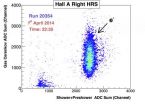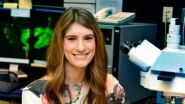(Press-News.org) Late on April 1, the crown jewel of the Department of Energy's Thomas Jefferson National Accelerator Facility ("Jefferson Lab") sparkled its way into a new era. Following an upgrade of the Continuous Electron Beam Accelerator Facility, the CEBAF accelerator delivered the highest-energy electron beams it has ever produced into a target in an experimental hall, recording the first data of the 12 GeV era. The machine sent electrons around the racetrack three times (known as "3-pass" beam), resulting in 6.11 GeV electrons at 2 nanoAmps average current for more than an hour.
"This achievement is a major milestone in the commissioning of the upgraded CEBAF," said Hugh Montgomery, Jefferson Lab director. "Although it's early yet as far as delivering beam for experiments, we are beginning to see the flowers that will become the fruits of our labors from this upgrade."
The CEBAF accelerator is a superconducting accelerator that had been designed to circulate electrons through one to five passes through the machine to deliver electron beams with maximum energies of 4 GeV, or 4 billion electron-volts. These beams were then delivered into one of the lab's three experimental areas, called halls, where they were directed into the nuclei of target materials for nuclear physics experiments. The original CEBAF provided its first electron beams to a target in an experimental hall in 1994. Due to efficiencies in the original design and experience gained by the operators in running the machine at its maximum potential, the original machine eventually achieved operating energies of 6 GeV.
In 2008, construction began for doubling the energy of the accelerator to 12 GeV. The 12 GeV Upgrade is a $338 million project that, in addition to doubling the maximum energy of the electron beams in Jefferson Lab's accelerator, also includes the construction of a fourth experimental hall and upgrades to equipment in the existing halls.
Since the accelerator was shut down for 18 months to complete the machine upgrade, it was anticipated that baby steps would be required to optimize the settings of hundreds of components in order to deliver the higher energy beam. The first electron beams at 6 GeV for 12 GeV commissioning were delivered into Experimental Hall A on April 1 at 4 p.m. for just over 11 minutes.
"I wanted a good, solid hour with beam availability at greater than 60 percent," said Arne Freyberger, Accelerator Operations manager and the program deputy on shift. Program deputies determine the priority for the accelerator when it's running. Freyberger's goal had yet to be demonstrated.
The accelerator crew on shift also included Crew Chief Mike McCaughan and Accelerator Operators Dan Moser and Brandi Cade. Accelerator Scientist Yan Wang recorded and provided insight into machine performance, and Yves Roblin was the Accelerator Physics Experimental Liaison for the Hall A beamline.
The crew tried again. At 7:15 p.m., the electron beam was delivered all the way to the Hall A beam dump. The 3-pass beam ran for only a few minutes before a power supply for the Personnel Safety System winked out, causing the system to fault and bringing down the accelerator. The system performed just as it was designed to in case of such a fault, ensuring that no workers were ever in harm's way. Henry Robertson came in on call to clear up the Personnel Safety System fault issue, so that the team could continue.
The team tried again and got beam moving just after 9 p.m. At 9:30 p.m., Freyberger called for the two graduate students monitoring Experimental Hall A to ask them to insert their carbon target into the beamline. Longwu Ou, a grad student at Massachusetts Institute of Technology, and Mongi Diamini, a grad student at Ohio University, complied.
Finally, at 10:25 p.m., the accelerator crew sent the first 6.1 GeV electrons into the experimental target and held it there for the next 75 minutes.
The run satisfied the requirement for 12 GeV Upgrade Project Level 2 Milestone (2-09) "Hall A Beam Commissioning Complete". The milestone is defined as "events recorded from beam-target interactions using the Hall A spectrometer detector systems with 3-pass > 6 GeV beam energy and at least 2 nA average beam current."
"We were here for it, but it really could have been any combination of our chiefs, operators and deputies, because we have put together such a great group of coworkers and colleagues," Freyberger commented.
The achievement of this milestone follows a critical accelerator commissioning step that was accomplished on Feb. 5, where electrons were sent around the accelerator at full upgrade energy acceleration of 2.2 GeV in one pass. This was the first run of the CEBAF accelerator at design specifications.
The next milestone in the commissioning of CEBAF at 12 GeV is the delivery of a 5.5-pass electron beam with an energy greater than 10 GeV to the Hall D Tagger Facility. The 12 GeV electrons will eventually generate the photon beam for Hall D in the Tagger. Electron beams with energies up to 11 GeV will be delivered to the other three experimental areas, Halls A, B and C. Upgraded and new equipment is being installed in those halls to expand the research capabilities available to scientists.
Delivering this beam energy was the first demonstration of beam beyond the original accelerator's operational energy and heralds the first beams for nuclear physics experiments in the 12 GeV era. Those first experiments will provide higher precision measurements of the structure of the proton (Precision Measurement of the Proton Elastic Cross Section at High Q2 and Measurements of the Electron-Helicity Dependent Cross Sections of Deeply Virtual Compton Scattering with CEBAF at 12 GeV) Both experiments will be run in Experimental Hall A.
INFORMATION:
Jefferson Science Associates, LLC, a joint venture of the Southeastern Universities Research Association, Inc. and PAE Applied Technologies, manages and operates the Thomas Jefferson National Accelerator Facility, or Jefferson Lab, for the U.S. Department of Energy's Office of Science.
DOE's Office of Science is the single largest supporter of basic research in the physical sciences in the United States, and is working to address some of the most pressing challenges of our time. For more information, visit science.energy.gov.
Beam on target!
CEBAF accelerator achieves 12 GeV commissioning milestone
2014-04-14
ELSE PRESS RELEASES FROM THIS DATE:
NASA sees remnants of Tropical Depression Peipah over Southern Philippines
2014-04-14
Tropical Depression Peipah has been very stubborn and has moved over the southern and central Philippines bringing clouds, showers and gusty winds. NASA-NOAA's Suomi NPP satellite captured an image that showed Peipah's clouds covering the Visayas and Mindanao regions of the country.
The VIIRS instrument aboard NASA-NOAA's Suomi NPP satellite captured a visible look at the remnant clouds associated with former Tropical Depression Peipah on April 14 at 4:24 UTC/12:24 a.m. EDT. The Visible Infrared Imaging Radiometer Suite (VIIRS) instrument collects visible and infrared ...
Pharmacists can significantly improve blood pressure, cholesterol in stroke patients
2014-04-14
Stroke patients managed by a pharmacist had a 12.5% improvement in blood pressure and low-density lipoprotein (LDL), or "bad" cholesterol levels compared with a control group, according to a clinical trial published in CMAJ (Canadian Medical Association Journal).
Patients who have a stroke or "mini stroke" (transient ischemic attack) are at high risk of adverse cardiovascular events. Management of high blood pressure and cholesterol after a stroke is important because it can substantially reduce the risk of a negative event; however, many patients receive suboptimal care. ...
'MicroRNA' could be key target for bowel cancer treatment
2014-04-14
Scientists found that the molecule, called microRNA 135b, is a vital 'worker' employed by several important cancer genes to drive the growth of bowel cancers.
Drugs targeted at the microRNA could knock out the effects of multiple cancer-causing mutations at once, while tests for it could identify patients with the most aggressive disease, the researchers believe.
The research was carried out by an international team including scientists based at The Institute of Cancer Research, London, the University of Glasgow and Ohio State University in the US.
Scientists tested ...
Study identifies a likely key driver of colorectal cancer development and progression
2014-04-14
COLUMBUS, Ohio – A new study identifies a molecule that is a probable driving force in colorectal cancer and suggests that the molecule could be an important target for colorectal cancer treatment and a valuable biomarker of tumor progression.
The study of microRNA-135b (miR-135b) in two animal models and human tumors was published in the journal Cancer Cell and was led by researchers at The Ohio State University Comprehensive Cancer Center – Arthur G. James Cancer Hospital and Richard J. Solove Research Institute (OSUCCC – James) and at the University of Glasgow in ...
Dietary supplement use among US adults more prevalent than previously thought
2014-04-14
Washington, D.C., April 14, 2014—Dietary supplement use by U.S. adults is more prevalent than indicated by published data from the National Health and Nutrition Examination Surveys (NHANES), according to a new article in the peer-reviewed Journal of the American College of Nutrition (JACN). The review article is based on five consecutive years of online market research studies, conducted by Ipsos Public Affairs for the Council for Responsible Nutrition (CRN).
According to Annette Dickinson, Ph.D., corresponding author and a consultant for CRN, "This new review adds to ...
Young dads at high risk of depression, too
2014-04-14
CHICAGO --- Depression can hit young fathers hard -- with symptoms increasing dramatically during some of the most important years of their children's lives, a new Northwestern Medicine® study has found.
Depressive symptoms increased on average by 68 percent over the first five years of fatherhood for these young men, who were around 25 years old when they became fathers and whom lived in the same home as their children. The results of the study were published April 14 in the journal Pediatrics.
This study is the first to identify when young fathers are at increased ...
Osteoporosis drugs appear to impede cell membrane repair
2014-04-14
AUGUSTA, Ga. –A class of drugs widely used to treat osteoporosis appears to impede a cell's ability to repair a protective outer membrane that helps determine what enters and exits, researchers report.
The inability to quickly repair a membrane is lethal to a cell and may help explain the rare and serious side effect of jawbone destruction that can occur following dental work in patients taking these drugs, said Caroline Lewis, a sophomore at the Medical College of Georgia at Georgia Regents University.
"The bottom line is it inhibits cell membrane repair in two distinct ...
Long-term antibiotic treatment for Q fever causes weight gain
2014-04-14
Scientists have unearthed still more evidence that antibiotics can contribute to obesity. Research published ahead of print in the journal Antimicrobial Agents and Chemotherapy suggests that patients on long-term antibiotic treatment gained weight and had significant changes in their gut microbiota.
The study, led by Didier Raoult, of Aix-Marseille University, Marseille, France, followed 48 patients who were being treated long-term with doxycycline and hydroxychloroquine for Q fever, and 34 control subjects. Nearly one quarter of the treated patients gained anywhere ...
Shiny quantum dots brighten future of solar cells
2014-04-14
A house window that doubles as a solar panel could be on the horizon, thanks to recent quantum-dot work by Los Alamos National Laboratory researchers in collaboration with scientists from University of Milano-Bicocca (UNIMIB), Italy. Their project demonstrates that superior light-emitting properties of quantum dots can be applied in solar energy by helping more efficiently harvest sunlight.
"The key accomplishment is the demonstration of large-area luminescent solar concentrators that use a new generation of specially engineered quantum dots," said lead researcher Victor ...
UT Dallas study: Youth who fail to envision future commit more crimes
2014-04-14
In a UT Dallas study involving serious youth offenders, the answer to one open-ended question predicted the teenagers' offending patterns for the next seven years: "How long do you think you'll live?"
According to the study, having little hope for the future encourages offending over time.
Author Dr. Alex Piquero said the study found those who don't view a very long life ahead of them offend at very high rates and commit more serious offenses, while those who believe they're going to die much later in life offend much less.
"In a lot of distressed communities and for ...
LAST 30 PRESS RELEASES:
UVA’s Jundong Li wins ICDM’S 2025 Tao Li Award for data mining, machine learning
UVA’s low-power, high-performance computer power player Mircea Stan earns National Academy of Inventors fellowship
Not playing by the rules: USU researcher explores filamentous algae dynamics in rivers
Do our body clocks influence our risk of dementia?
Anthropologists offer new evidence of bipedalism in long-debated fossil discovery
Safer receipt paper from wood
Dosage-sensitive genes suggest no whole-genome duplications in ancestral angiosperm
First ancient human herpesvirus genomes document their deep history with humans
Why Some Bacteria Survive Antibiotics and How to Stop Them - New study reveals that bacteria can survive antibiotic treatment through two fundamentally different “shutdown modes”
UCLA study links scar healing to dangerous placenta condition
CHANGE-seq-BE finds off-target changes in the genome from base editors
The Journal of Nuclear Medicine Ahead-of-Print Tip Sheet: January 2, 2026
Delayed or absent first dose of measles, mumps, and rubella vaccination
Trends in US preterm birth rates by household income and race and ethnicity
Study identifies potential biomarker linked to progression and brain inflammation in multiple sclerosis
Many mothers in Norway do not show up for postnatal check-ups
Researchers want to find out why quick clay is so unstable
Superradiant spins show teamwork at the quantum scale
Cleveland Clinic Research links tumor bacteria to immunotherapy resistance in head and neck cancer
First Editorial of 2026: Resisting AI slop
Joint ground- and space-based observations reveal Saturn-mass rogue planet
Inheritable genetic variant offers protection against blood cancer risk and progression
Pigs settled Pacific islands alongside early human voyagers
A Coral reef’s daily pulse reshapes microbes in surrounding waters
EAST Tokamak experiments exceed plasma density limit, offering new approach to fusion ignition
Groundbreaking discovery reveals Africa’s oldest cremation pyre and complex ritual practices
First breathing ‘lung-on-chip’ developed using genetically identical cells
How people moved pigs across the Pacific
Interaction of climate change and human activity and its impact on plant diversity in Qinghai-Tibet plateau
From addressing uncertainty to national strategy: an interpretation of Professor Lim Siong Guan’s views
[Press-News.org] Beam on target!CEBAF accelerator achieves 12 GeV commissioning milestone




